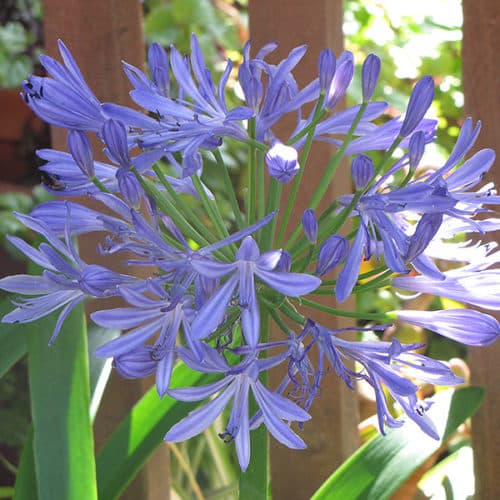Sensational Agapanthus: Enhancing Your Garden's Charm
Sensational Agapanthus: Enhancing Your Garden's Charm
Blog Article
Mastering the Art of Agapanthus Treatment: Essential Steps for Healthy Growth and Lively Blooms
In the world of gardening, the growing of agapanthus stands as a satisfying undertaking for those who look for to support these elegant blooming plants. From choosing the ideal range to grasping pruning techniques, the journey in the direction of cultivating flourishing agapanthus plants is multifaceted and holds the key to opening the full possibility of these botanical treasures.

Picking the Right Agapanthus Range

When picking the ideal Agapanthus variety for your yard, take into consideration factors such as environment suitability, flower color, and growth habit. Furthermore, consider the environment in your area to make certain the Agapanthus selection you select can flourish in your certain conditions. Comprehending the development routine of various Agapanthus ranges is crucial for appropriate positioning within your garden.
Ideal Growing Problems
Taking into consideration the ideal environmental requirements is crucial for successful Agapanthus growing. Agapanthus plants are delicate to chilly temperature levels and need to be secured from frost throughout winter months.
To ensure healthy and balanced growth and dynamic flowers, plant Agapanthus light bulbs at a depth of regarding 2-4 inches and area them 8-12 inches apart. Adding raw material, such as garden compost, to the dirt can boost water drainage and fertility, advertising robust root advancement. Mulching around the base of the plants aids maintain wetness and reduces weed growth. Normal watering is important, particularly during the growing period, to keep the soil continually wet however not waterlogged.
Watering and Feeding Tips
Preserving appropriate wetness levels and offering essential nutrients are crucial aspects in the care program for Agapanthus plants. When it pertains to sprinkling Agapanthus, it is crucial to strike a balance. If overwatered, these plants choose consistently wet soil however are at risk to root rot. Throughout the growing period, water deeply when a week, making sure the soil is well-draining to stop waterlogging. In hotter environments or throughout periods of drought, more constant watering may be needed to keep the soil equally damp. Nonetheless, decrease watering in the wintertime to stop waterlogged conditions.
Fertilizing Agapanthus is essential for advertising healthy growth and respected blooms. Apply a well balanced plant food, such as a 10-10-10 formula, in the very early spring as new growth arises. By following these watering and fertilizing suggestions, you can ensure your Agapanthus plants thrive and produce vibrant, long-lasting flowers.
Pruning Methods for Agapanthus
Trimming Agapanthus plants at the appropriate times and with correct methods is crucial for preserving their health and wellness and advertising optimal growth and blooming. The ideal time to prune Agapanthus is in late winter season or very early spring prior to new development emerges.
Deadheading spent flowers can likewise reroute the plant's energy into producing more blossoms instead than establishing seeds. If you desire to collect seeds for proliferation, leave some flowers to dry and fully grown on the plant.
Keep in mind to utilize clean, sharp tools to make precise cuts and reduce the danger of presenting conditions. Agapanthus. Regular pruning will certainly assist maintain your Agapanthus looking cool and healthy while ensuring a plentiful screen of stunning blooms
Dealing With Usual Pests and Illness
After guaranteeing correct pruning methods check over here for Agapanthus, it is vital to deal with common bugs and illness that can affect the health and wellness and vitality of these plants. One usual insect that impacts Agapanthus is the Agapanthus gall midge.
Another typical issue is fungal fallen leave area, which presents as dark lesions on the leaves. To stop fungal illness, make sure great air blood circulation around the plants, stay clear of overhead watering, and eliminate any type of contaminated leaves promptly. Additionally, Agapanthus plants can deal with root rot if they are planted in improperly draining dirt. To stop this, plant Agapanthus in well-draining soil and stay news clear of overwatering. By being vigilant and taking prompt action against conditions and pests, you can aid your Agapanthus plants prosper and produce vibrant blossoms.

Final Thought
To conclude, understanding the art of agapanthus treatment includes picking the best selection, supplying suitable growing conditions, appropriate watering and feeding, appropriate trimming strategies, and addressing typical pests and diseases. By following these vital steps, you can guarantee healthy and balanced development and dynamic blossoms for your agapanthus plants. Remember to consistently keep track of and maintain your plants to promote their general wellness and longevity.
To make certain healthy development and dynamic flowers, plant Agapanthus light bulbs at a deepness of concerning 2-4 inches and room them 8-12 inches apart. By complying with these watering and feeding suggestions, you can guarantee your Agapanthus plants grow and generate lively, resilient blossoms.
One common bug that affects Agapanthus is the Agapanthus gall straight from the source midget. Furthermore, Agapanthus plants can endure from origin rot if they are grown in improperly draining pipes dirt. By following these necessary steps, you can ensure healthy and balanced development and dynamic blossoms for your agapanthus plants.
Report this page